How Does Understanding Transactional, Informational, Navigational, and Commercial Keyword Intent Elevate Your SEO Strategy?
What is Keyword Intent?
Keyword intent, or search intent, refers to the underlying purpose behind a user’s search query. It reveals what the user aims to accomplish by typing certain keywords into a search engine. Understanding keyword intent is vital for SEO because it allows marketers to create content that meets user needs effectively. By aligning content with the underlying intent, businesses can enhance user experience, increase engagement, and improve conversion rates.
Importance of Understanding Keyword Intent in SEO
When you grasp keyword intent, you can tailor your SEO strategy to ensure that your content resonates with your audience. This alignment not only improves the chances of ranking higher in search results but also leads to higher engagement and conversion rates. For instance, content that answers a user’s question directly tends to perform better because it fulfills their immediate needs.
Case Study: How Targeting Keyword Intent Increased Traffic
Consider a blog that provides financial advice. Initially, their content was broad and covered topics like “investing,” “saving,” and “budgeting.” However, they noticed that their traffic was stagnating. After conducting keyword research, they discovered a high volume of searches for “best budgeting apps 2024.” By creating a dedicated article addressing this specific query, they aligned their content with user intent. As a result, their traffic increased by 150% within three months, demonstrating how understanding keyword intent can significantly boost visibility and engagement.
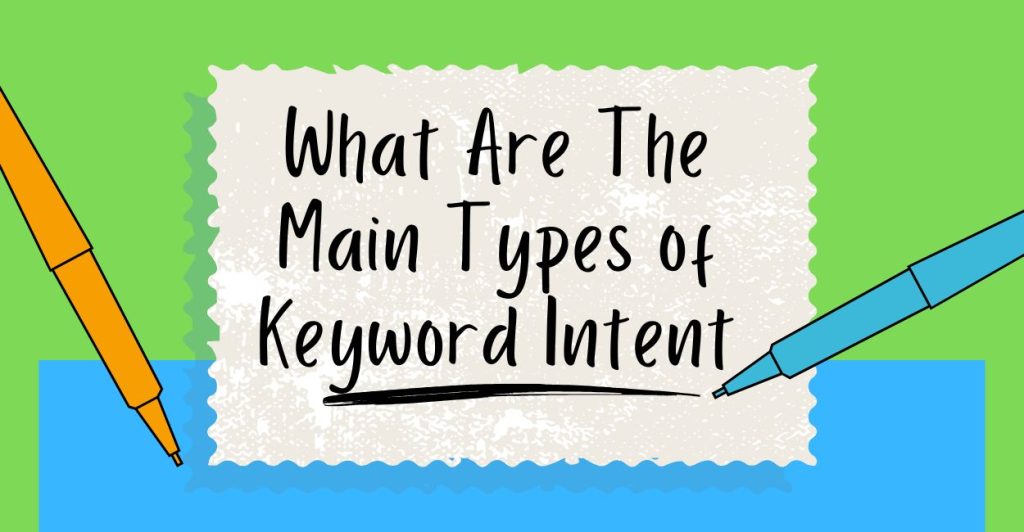
The Main Types of Keyword Intent
Understanding the main types of keyword research intent—transactional, informational, navigational, and commercial—allows businesses to create targeted content that resonates with their audience. Each type serves a unique purpose in the user’s journey and requires different approaches in content creation.
1. Transactional Keywords
Definition and Examples
Transactional keywords indicate that a user is ready to make a purchase or complete a specific action. These keywords often include terms like “buy,” “discount,” “for sale,” or “order.” For example, “buy running shoes online” clearly shows the user’s intent to make a purchase.
How to Find Transactional Keywords Using Google Keyword Planner
Google Keyword Planner is a free tool provided by Google Ads, primarily for advertisers, but it’s also a powerful resource for finding transactional keywords that indicate purchase intent. These keywords often include action verbs like “buy,” “order,” “discount,” “deal,” or “near me.” Below, we’ll walk through a step-by-step practical example of using Google Keyword Planner effectively to find transactional keywords.
Step 1: Access Google Keyword Planner
- Go to Google Ads and log in with your Google account.
- Navigate to Tools & Settings > Keyword Planner.
- Select “Discover New Keywords.”
Step 2: Enter Product or Service Keywords
In the keyword search field, enter a product or service. Let’s assume you are selling wireless headphones. Type:
- “wireless headphones”
- “Bluetooth headphones”
You can enter multiple keywords to get broader results.
Step 3: Filter for Transactional Keywords
Once the keyword suggestions load, follow these steps to narrow down the results to transactional keywords:
- Apply the Competition Filter: Set it to “High”—this helps you see keywords where advertisers are actively bidding, which indicates they have transactional intent.
- Focus on Bidding Data: Look at the Top-of-Page Bid (High Range) column. Keywords with higher bids indicate that businesses are willing to pay more, signaling high intent to convert users.
- Add Intent Keywords: Use the “Include Keywords” filter, and type in words like:
- buy
- order
- deal
- discount: This narrows the list to transactional phrases only.
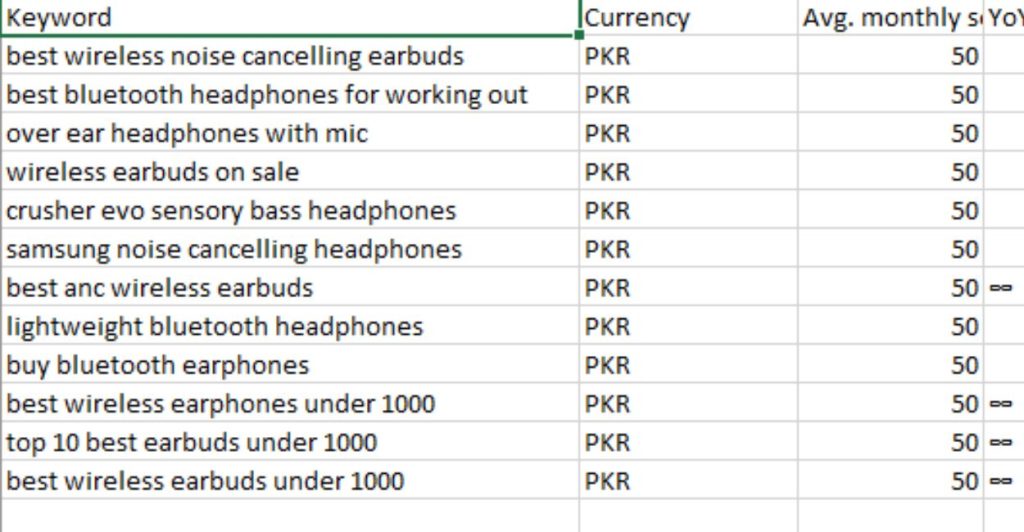
Step 4: Analyze the Results
After filtering, you will get results such as:
- “lightweight bluetooth headphones” – High search volume and high bids
- “discount Bluetooth headphones” – Low competition but high purchase intent
- “wireless headphones near me” – Local transactional intent
- “best wireless headphones deals” – A mix of transactional and commercial intent
These keywords show clear intent to purchase, making them ideal for product pages or PPC campaigns.
Step 5: Practical Use of Keywords
- Product Pages: Use keywords like “lightweight bluetooth headphones” in your product titles and descriptions.
- Landing Pages: Create landing pages targeting deals with keywords like “discount Bluetooth headphones.”
- PPC Campaigns: Use high-bid transactional keywords in your Google Ads campaigns to attract buyers with purchase intent.
- Local SEO: Optimize local landing pages with keywords like “wireless headphones near me” to capture local customers ready to buy.
Bonus Tips for Using Google Keyword Planner Effectively
- Use Location Filters:
If you’re targeting a specific region, apply location-based filters to
find transactional keywords relevant to that area. - Analyze Search Trends: Use the Search Volume Trends graph in Keyword
Planner to identify seasonal keywords that perform better during certain
periods (e.g., “best Black Friday deals on headphones”). - Expand Keyword Ideas:
Click on “Keyword Suggestions” to find related transactional
keywords, expanding your list for better SEO and ad targeting.
Summary
Using Google Keyword Planner effectively allows you to find transactional keywords by focusing on high competition, bidding data, and keyword research with purchase intent. For example, filtering with action words like “buy” and “discount” reveals phrases such as “buy wireless headphones” and “discount Bluetooth headphones.” These keywords are perfect for product pages, PPC ads, and landing pages, ensuring your SEO strategy aligns with user intent to maximize conversions.
2. Informational Keywords
Definition and Examples
Informational keywords are employed when users seek answers to specific questions or wish to gain knowledge about a particular subject. Examples include phrases like “how to start a blog” or “what is digital marketing.” These indicate that users are in the research phase.
How to Find Informational Keywords Using Google Keyword Planner
Google Keyword Planner is a free tool that provides valuable keyword data. Here’s a step-by-step guide to help you identify informational keywords effectively.
Step 1: Access Google Keyword Planner
- Go to Google Keyword Planner.
- Sign in with your Google account. You don’t need to run ads; just create an account if you don’t have one.
- Select Discover New Keywords.
Step 2: Enter a Broad Keyword
- In the Search bar, type a broad topic relevant to your niche. For example, if you’re looking for informational keywords about SEO, type “SEO basics” or “SEO guide.”
- Click Get Results to generate keyword ideas.
Step 3: Analyze the Results
When the results load, you’ll see a table with keyword suggestions along with key metrics such as:
- Search Volume: Represents the average number of times the keyword is searched each month.
- Competition: A low to high scale indicating how many advertisers are targeting the keyword.
- Top of Page Bid (Low/High): Cost per click estimates if the keyword were used in ads.
Step 4: Identify Informational Keywords
Look for keywords that reflect informational intent—queries where users are seeking knowledge rather than looking to buy. Some common indicators of informational keywords include words like:
- What, How, Guide, Tutorial, Tips, Best, Benefits, Examples.
Example Result:
- “How to improve SEO on WordPress”
- “What is SEO optimization?”
These keywords indicate users are seeking educational content, making them ideal for blog posts, guides, or explainer videos.
Step 5: Filter for Relevant Keywords
- Utilize the filters at the top to narrow down your results:
- Competition: Choose Low or Medium to focus on less competitive keywords.
- Keyword Text: Include words like “how” or “what” to narrow down to informational queries.
- Sort by Search Volume to find high-traffic keywords that align with informational intent.
Step 6: Export the Data
- Click on Download Keyword Ideas in the upper-right corner to export the keyword data in a CSV file.
Use the exported data to plan content—blog articles, tutorials, or FAQs—based on the most relevant informational keywords.
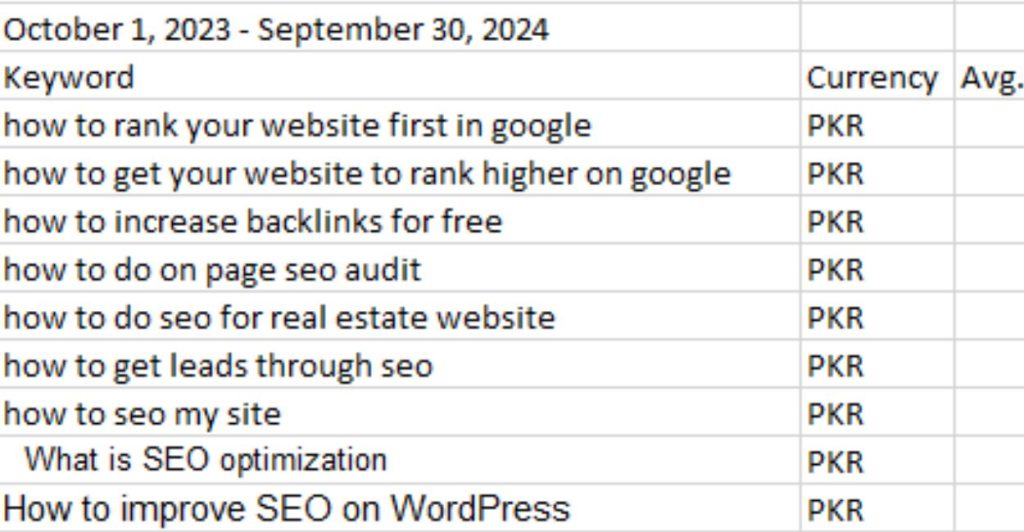
Example: How to Use an Informational Keyword in Content
Let’s say you found “How to improve SEO on WordPress” in your results. You can write a detailed blog post explaining step-by-step strategies like:
- Installing SEO plugins (e.g., Yoast or RankMath)
- Optimizing page titles and meta descriptions
- Creating XML sitemaps for better indexing
Incorporate other related keywords from the tool within your content to strengthen your SEO efforts.
Step 7: Monitor Keyword Performance
Once you’ve created content, use Google Analytics or Google Search Console to track the performance of your chosen keywords. Look for metrics such as click-through rates (CTR) and ranking improvements.
3. Navigational Keywords
Definition and Examples
Navigational keywords are used when users intend to visit a specific website or page. For example, searching “Facebook login” indicates that the user wants to go directly to Facebook’s login page.
How to Find Navigational Keywords Using Site Search Queries
To identify navigational keywords, follow these simple steps using an example website, IKEA.com:
-
Check Internal Search Data:
- Where to Look: Log into your website analytics, like Google Analytics. Go to the Behavior section and select Site Search > Search Terms.
- What to Find: Look for the most common search terms users type into IKEA.com.
-
Identify Common Searches:
- Examples: If users frequently search for “Contact Us,” “Delivery Information,” or “Return Policy,” these are your navigational keywords. They indicate specific pages users are trying to access.
-
Optimize Navigation:
- Make it Easier: If “Contact Us” is a top search, ensure that this page is easy to find in the main menu. For “Delivery Information,” consider adding a prominent link on the homepage.
- Create Relevant Content: If many users search for “Return Policy,” develop a detailed returns page and link it in multiple places.
-
Monitor Ongoing Searches:
- Stay Updated: Regularly check IKEA.com’s site search queries to see if new trends emerge. Adjust the navigation as needed to match user behavior.
Quick Example:
For IKEA.com, if the top searches are “Sofa Buying Guide” and “Order Tracking,” you should:
- Create a page for Sofa Buying Guide featuring tips and product recommendations.
- Make the Order Tracking link easy to find in the site’s navigation.
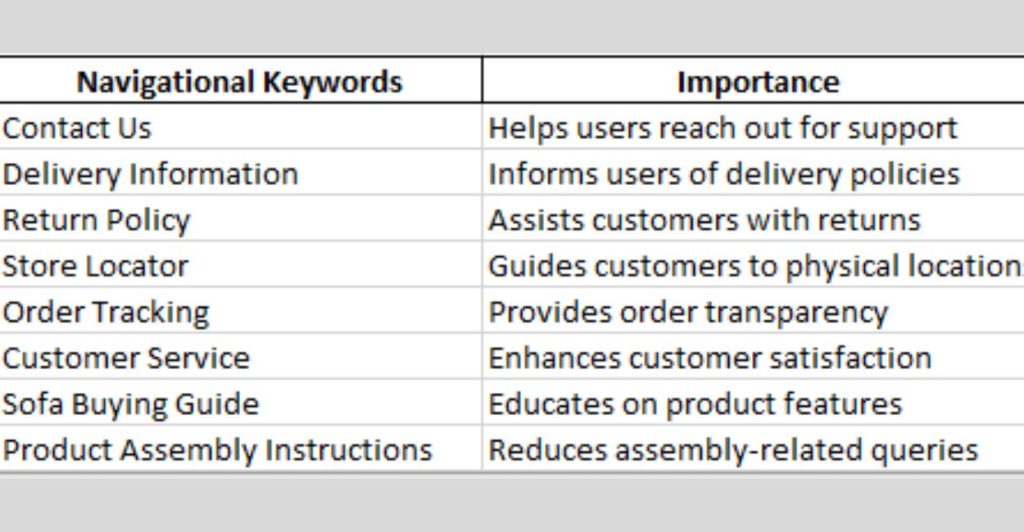
Content Types for Navigational Keywords
Content for navigational keywords should include:
- Homepage Optimization: Ensure your homepage effectively conveys your brand message and directs users to the desired actions.
- Brand Pages: Create dedicated pages for your brand that provide all relevant information.
4. Commercial Keywords
Definition and Examples
Commercial keywords are used by potential buyers who are comparing products or services before making a purchase. These keywords often include phrases like “best laptops for students” or “top-rated smartphones.” They indicate that the user is in the consideration phase of the buying process.
How to Find Commercial Keywords
Review Competitor Content
Analyzing your competitors is a great way to uncover commercial keywords that can drive traffic to your website. Here’s how to do it:
- Determine Your Competitors: Start by pinpointing the key players in your industry. For example, if you’re involved in the furniture sector, notable competitors could include websites such as IKEA, Wayfair, and Ashley HomeStore.
- Analyze Their Content: Visit your competitors’ websites and look for product pages, landing pages, and blog posts. Pay attention to the keywords they are using in their titles, headings, meta descriptions, and throughout the content.
Example: If you analyze IKEA’s website, you might find keywords like:
- “Buy sofas online”
- “Best dining room sets”
- “Affordable bedroom furniture”
These phrases indicate strong commercial intent, as users searching for these terms are likely ready to make a purchase.
- Check Their Top Pages: Use tools like BuzzSumo to see which pages from your competitors are getting the most engagement. Focus on pages that rank highly for product-related searches, as they are likely optimized for commercial keywords.
Use Keyword Research Tools
SEMrush:
SEMrush is a powerful tool that can help you discover commercial keywords that drive traffic to your competitors websites. Here’s a step-by-step guide:
- Log into SEMrush: If you don’t have an account, you can sign up for a free trial to explore the features.
- Enter a Competitor’s Domain: In the SEMrush dashboard, enter a competitor’s domain in the search bar. For example, you can use IKEA.com.
- Analyze the Domain Overview: Click on the “Domain Overview” tab. This will give you a snapshot of the domain’s organic search traffic, keywords, and position distribution.
- Navigate to the “Organic Research” Section: Click on the “Organic Research” tab in the left sidebar. Here, you will find valuable data about the keywords your competitor ranks for.
- Filter by Intent: Use filters to focus specifically on commercial intent keywords. You can look for keywords that include terms like “buy,” “best,” “top,” “discount,” or “sale.” For example, search for keywords like:
- “Buy kitchen furniture online”
- “Best office chairs for home”
- Export the Data: You can export the keyword list to analyze them further. This will help you identify which commercial keywords are driving traffic to your competitor.
Example: After analyzing IKEA’s keywords through SEMrush, you might discover that they rank for:
- “Discount sofa bed”
- “Luxury dining table”
- “Office furniture sale”
These keywords are commercial in nature, indicating users are in the buying phase.
Conclusion
Finding commercial keywords involves both analyzing competitor content and leveraging powerful keyword research tools like SEMrush. By combining insights from both methods, you can develop a strong list of commercial keywords that can enhance your SEO strategy and attract customers ready to make a purchase. If you want to get the information about short-tail and long-tail-keywords in SEO read this.
| Keyword | Intent |
|---|---|
| Buy IKEA furniture | Commercial |
| IKEA kitchen deals | Commercial |
| IKEA sofa sales | Commercial |
| IKEA home decor | Commercial |
| IKEA bedroom furniture | Commercial |
| IKEA office furniture | Commercial |
| IKEA outdoor furniture | Commercial |
| IKEA furniture assembly services | Commercial |
Content Types for Commercial Keywords
When creating content for commercial keywords, focus on:
- Comparison Articles: Write in-depth comparisons between products to help users make informed decisions.
- Product Reviews: Provide comprehensive reviews that highlight features, pros, and cons.
- Buyer’s Guides: Create guides that help users choose the best product for their needs.
Transactional vs. Informational vs. Commercial – What Should You Care About?
Understanding the differences between transactional, informational, and commercial keywords is crucial for your SEO strategy. Each keyword type fulfills distinct user intents:
- Transactional Keywords: Drive immediate purchases and conversions.
- Informational Keywords: Attract users seeking knowledge, allowing you to build authority and trust.
- Commercial Keywords: Guide users who are in the research phase, helping them move closer to a purchase.
Implications for SEO Strategies and Conversion Rates
Focusing on the right keywords can significantly impact your SEO performance. For example, optimizing content for transactional keywords can directly lead to increased sales. In contrast, informational content can build brand awareness and authority, creating a foundation for future conversions.
Combining Keyword Types in SEO
Why Is Search Intent Important for SEO?
Search intent is critical for creating a comprehensive SEO strategy. Different types of keywords fulfill varying user intents, and recognizing this can help businesses tailor their content accordingly. For example, an e-commerce site may want to optimize for transactional keywords to drive sales while also producing informational content to attract new visitors.
How to Use Each Keyword Type Effectively
To effectively use each keyword type in your SEO efforts:
- Integrate Transactional Keywords: Focus on CTAs that encourage users to make a purchase.
- Leverage Informational Keywords: Use these to drive traffic and establish expertise in your niche.
- Utilize Commercial Keywords: Create content that aids users in their decision-making process..
Optimizing Content for Search Intent
To optimize content for navigational intent:
- Ensure Clear Branding: Your brand name should be prominent across your website.
- Simplify Navigation: Create intuitive menus that lead users to key pages quickly.
Optimizing for Informational Intent
Best practices for optimizing content for informational intent include:
- Use Clear Headings: Make content skimmable by using H2 and H3 headings.
- Answer Questions Directly: Address common questions within your content.
Optimizing for Transactional Intent
To optimize for transactional intent:
- Prominent CTAs: Ensure that CTAs are visible and encourage users to take action.
- Trust Signals: Include reviews and testimonials to build credibility.
Optimizing for Commercial Investigation Intent
Best practices include:
- Comparison Charts: Create charts that clearly show product differences.
- Create Captivating Content: Incorporate dynamic formats such as videos and infographics to capture attention.
| Search Intent | Optimization Strategies |
|---|---|
| Navigational Intent |
|
| Informational Intent |
|
| Transactional Intent |
|
| Commercial Investigation Intent |
|
Improving Existing Content Based on Keyword Intent
Evaluating Existing Content for Keyword Intent Alignment
To improve existing content:
- Audit Current Content: Assess whether it aligns with the current keyword intent.
- Update Keywords: Refresh outdated keywords with more relevant ones that align with user intent.
- Revise Content: Enhance content to better address user needs.
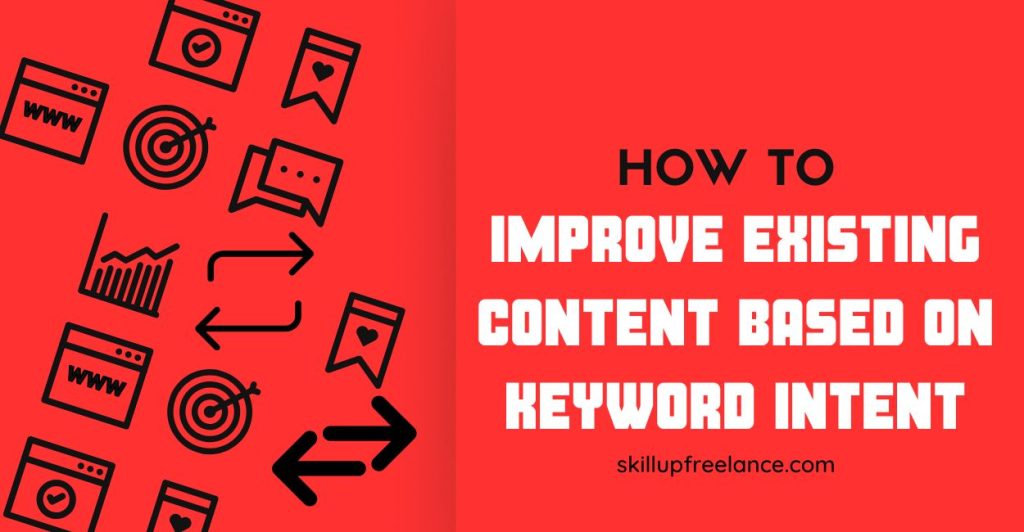
Case Study: Updating Content for Better Alignment
A travel blog previously focused solely on general travel tips. After evaluating their content, they identified opportunities to incorporate more transactional keywords related to travel booking. By updating their posts to include specific calls to action, like “book your flight now,” they increased their conversion rate by 40%.
Optimizing for User Experience to Align with Search Intent
Importance of User Experience (UX) in SEO
User experience is a critical factor that influences how search engines rank your content. A well-optimized UX not only helps retain visitors but also encourages them to engage with your site, ultimately improving conversion rates. Key elements of UX to consider include:
- Page Load Speed: A slow-loading website can deter users, leading to high bounce rates. Tools like Google PageSpeed Insights can help you identify areas for improvement.
- Mobile Responsiveness: With an increasing number of users accessing websites via mobile devices, ensuring your site is mobile-friendly is essential. This means using responsive design, optimizing images, and ensuring that buttons and links are easily clickable.
- Clear Navigation: A well-organized website with intuitive navigation allows users to find the information they need quickly. Use breadcrumb navigation and clear categories to guide users through your site.
- Engaging Content Layout: Break up text with headings, bullet points, and images to make your content more digestible. Engaging content is more likely to keep users on your site longer.
Case Study: UX Improvements Leading to Higher Engagement
A leading e-commerce site struggled with high bounce rates and low conversion rates. After a thorough UX audit, they implemented several changes, including improving page load speed, optimizing the mobile experience, and simplifying their checkout process. As a result, they saw a 60% decrease in bounce rates and a 30% increase in conversions within six months. This case illustrates how UX enhancements can align with keyword intent to create a more satisfying user experience, ultimately driving better SEO performance.
Importance of Regular SEO Audits
SEO is not a one-time task; it requires ongoing monitoring and adjustments. Regular audits help you evaluate the effectiveness of your strategies and ensure that your content remains aligned with user intent. Consider conducting audits every few months to:
- Assess Keyword Performance: Analyze which keywords are driving traffic and which are underperforming.
- Evaluate Content Quality: Ensure your content remains relevant and valuable to your audience.
- Identify New Opportunities: Keep an eye on emerging trends and keywords to stay ahead of the competition.
Tools for Monitoring SEO Performance
Utilize tools like Google Analytics and SEMrush to track your website’s performance. Google Analytics provides insights into user behavior, helping you understand which pages are most popular and where users drop off. SEMrush allows you to monitor keyword rankings, backlink profiles, and overall site health.
Adjusting Your Strategy Based on Insights
Use the insights gained from your audits to refine your SEO strategy. For example, if you notice that certain informational articles are driving significant traffic, consider expanding them into comprehensive guides or creating related content to capitalize on that interest.
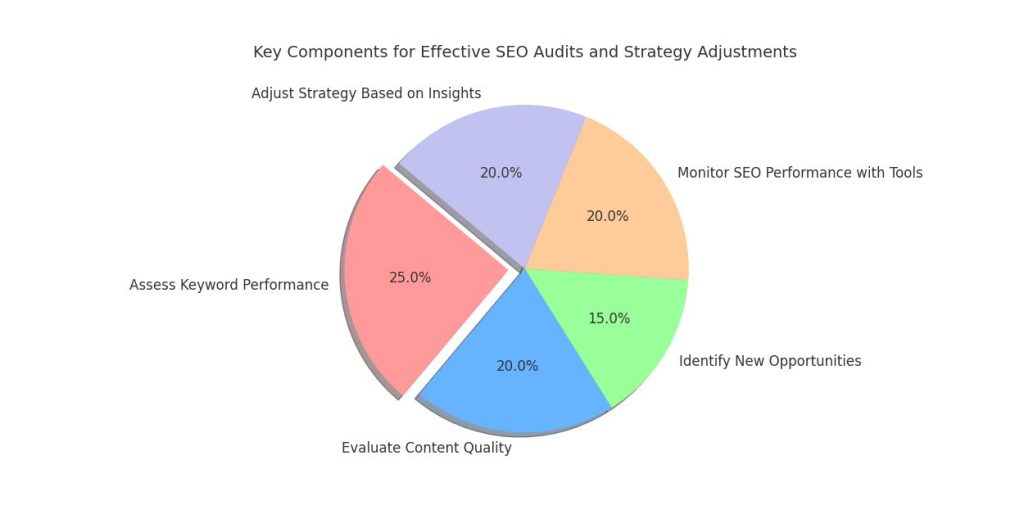
Conclusion
Understanding keyword intent—transactional, informational, navigational, and commercial—is essential for creating an effective SEO strategy. By aligning your content with the specific needs and motivations of your audience, you can improve your website’s visibility, engagement, and conversion rates.
As you develop your SEO strategy, consider the following key takeaways:
- Focus on User Intent: Always prioritize understanding what your users are looking for and tailor your content to meet those needs.
- Utilize Keyword Research Tools: Leverage tools like Google Keyword Planner and SEMrush to uncover valuable keyword opportunities.
- Regularly Optimize Content: Continually evaluate and refine your content to ensure it remains relevant and effective in fulfilling user intent.
- Enhance User Experience: Prioritize UX to keep visitors engaged and encourage conversions.
- Monitor and Adapt: Regular audits and adjustments to your strategy will help you stay ahead of the competition and maximize your SEO efforts.
By taking these steps, you’ll be well on your way to creating a robust SEO strategy that effectively leverages keyword intent to drive success.
Final Thoughts
Understanding keyword intent is not just about improving your SEO rankings; it’s about creating a better experience for your users. By focusing on the different types of keyword intent and adjusting your strategy accordingly, you can drive more traffic, increase engagement, and ultimately achieve your business goals.
This approach requires continuous learning and adaptation. If you want to know the more SEO ranking factor read this.
Frequently Asked Questions (FAQs)
- What Are the Key Points for SEO Success When Understanding Keyword Intent?
To achieve SEO success by understanding keyword intent, consider the following key points:
- Identify User Needs: Research and analyze what users are searching for to align your content with their needs.
- Segment Keyword Types: Recognize the differences between transactional, informational, navigational, and commercial keywords to create targeted content.
- Utilize Tools Effectively: Leverage keyword research tools to uncover insights and trends relevant to your target audience.
- Optimize Content Accordingly: Ensure that your content answers specific user queries and provides value, enhancing engagement and conversion rates.
- Regularly Monitor Performance: Continuously assess and adapt your SEO strategies based on user behavior and content performance.
- What Are Informational Keywords in the SEO Research Process?
Informational keywords are phrases that users search for when seeking knowledge or answers to specific questions. These keywords often begin with words like “what,” “how,” or “why.” They are crucial in the SEO research process because they help in understanding user intent and providing valuable content that meets those needs. By targeting informational keywords, you can drive traffic to your site from users looking for resources, guides, or educational content.
- How Do Informational Keywords Differ from Transactional Keywords in SEO?
Informational keywords focus on providing knowledge and answering questions, while transactional keywords indicate a user’s intent to make a purchase or complete a specific action. For instance, an informational keyword might be “how to bake a cake,” whereas a transactional keyword could be “buy cake mix online.” Understanding this distinction allows marketers to tailor their content to either inform or facilitate purchases, depending on user intent.
- How Do Navigational Keywords Impact a Website’s SEO Strategy?
Navigational keywords are used by users who know where they want to go and are looking for a specific website or page. These keywords can significantly impact SEO strategy by guiding the creation of branded content and optimizing for local search queries. For example, using navigational keywords can improve the visibility of brand pages or specific landing pages, enhancing direct traffic and improving overall website authority.
- What Role Do Commercial Keywords Play in Targeting Potential Customers?
Commercial keywords indicate that a user is in the research phase before making a purchase. They often include phrases like “best,” “top,” or “reviews.” By targeting these keywords, businesses can attract potential customers who are comparing products or looking for options. Effective use of commercial keywords can drive traffic to product comparison pages, guides, and reviews, ultimately leading to higher conversion rates as users move closer to making a purchase decision.
- How Can Informational Keywords Help Improve Content Visibility in Search Engines?
Informational keywords can improve content visibility by aligning your content with common user queries. When your content provides answers to popular informational searches, it has a higher chance of ranking well in search engine results pages (SERPs). Additionally, creating high-quality, informative content that targets these keywords can establish your authority in your niche, leading to increased backlinks and social shares, which further enhance visibility.
- What Are Some Examples of Transactional Keywords, and When Should They Be Used?
Examples of transactional keywords could be phrases like “order shoes online” “reserve a flight,” or “sign up for Netflix.” These keywords are ideally placed on product and service pages, landing pages, and within calls-to-action to drive users toward making purchases or subscribing to services. Incorporating transactional keywords effectively helps guide users towards completing actions that contribute to your business goals.
- How Does User Intent Differ Between Informational and Navigational Keywords?
User intent for informational keywords is primarily focused on gaining knowledge or answers to specific questions, while navigational keywords indicate a desire to reach a specific website or web page. For example, a user searching for “how to fix a leaky faucet” is looking for information, whereas someone searching for “Home Depot” intends to visit the Home Depot website. Understanding this difference allows you to create content that matches the appropriate user needs.
- Why Is It Important to Understand the Difference Between Transactional and Commercial Keywords?
Grasping the distinction between transactional and commercial keywords is essential for fine-tuning your content strategy. Transactional keywords indicate a readiness to purchase, while commercial keywords suggest a research phase. By targeting both types effectively, you can guide users through their buyer’s journey—from awareness to consideration to purchase—enhancing the overall effectiveness of your SEO strategy.
- How Can Using Navigational Keywords Improve User Experience on a Website?
Using navigational keywords can enhance user experience by ensuring that users find the information or services they are looking for quickly and efficiently. By optimizing for these keywords, you can make your site easier to navigate, reducing frustration and improving satisfaction. For instance, clearly labeled brand pages and intuitive site architecture can facilitate better navigation, leading to increased time spent on the site and a lower bounce rate.